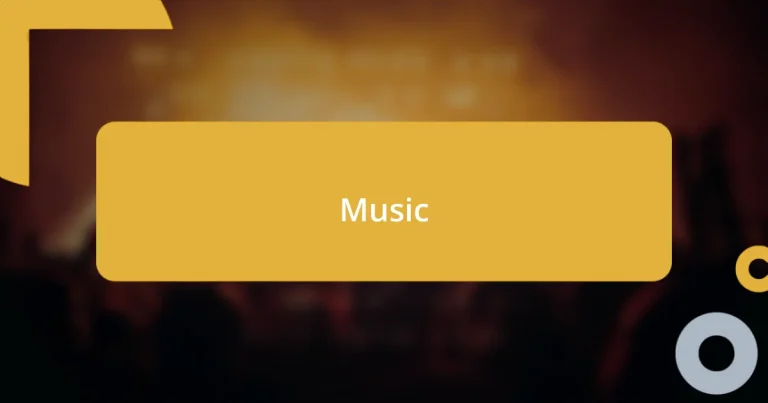Key takeaways:
- Maintaining clean code principles emphasizes clarity through small, focused functions and meaningful naming conventions, enhancing readability and communication.
- Consistent coding styles improve collaboration and maintainability, leading to better productivity and fewer errors within teams.
- Regular refactoring, thorough documentation, and utilizing coding standards tools foster innovation, streamline workflows, and enhance code quality over time.
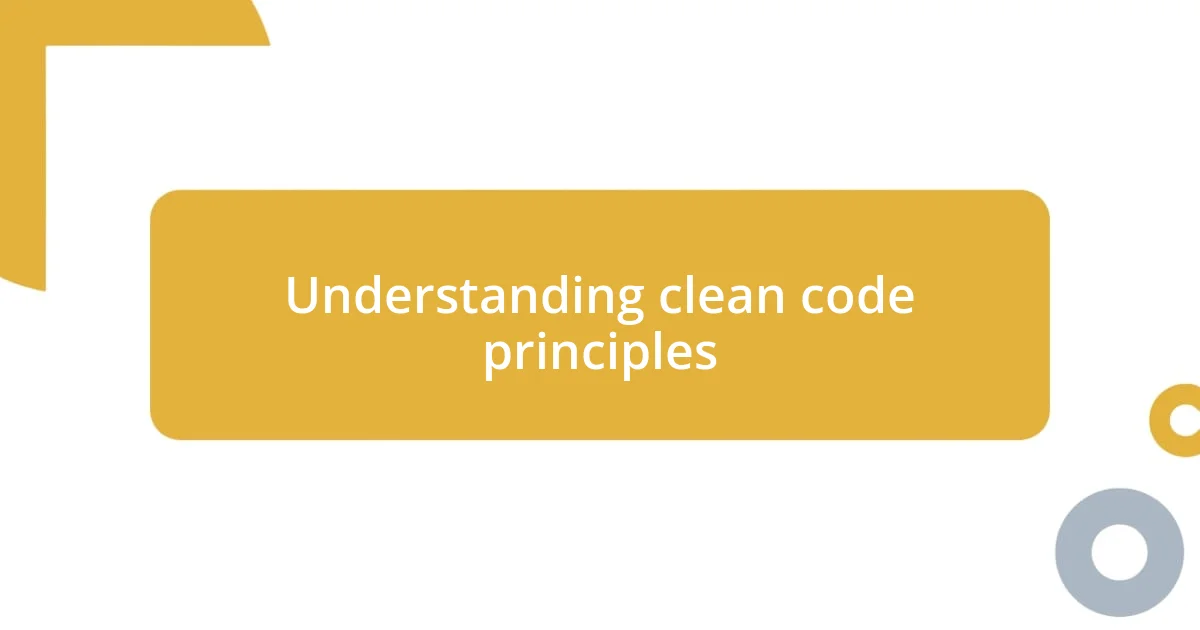
Understanding clean code principles
Understanding clean code principles goes beyond just writing code that functions; it’s about crafting code that communicates effectively. I remember a project where I spent hours refactoring because the original code was a tangled mess, and it hit me hard—if I’m struggling to understand my own work, how will anyone else? It was a wake-up call that emphasized the importance of clarity.
One key principle I embrace is keeping functions small and focused. Have you ever tried to parse through a lengthy function full of branching conditions? It’s like wandering through a maze without a map. In my experience, breaking down complex tasks into smaller, manageable functions not only clarifies intent but also makes testing and debugging so much easier. It’s amazing how a little structure can save hours down the line.
The principle of naming conventions is another critical aspect I value. I once worked with a teammate who named variables using single letters, and while it seemed clever at the time, it made the entire codebase feel like a code-breaking challenge. Thoughtful naming fosters understanding and can even spark joy when revisiting your code in the future. After all, why should your code feel like a foreign language when it can tell a clear story?
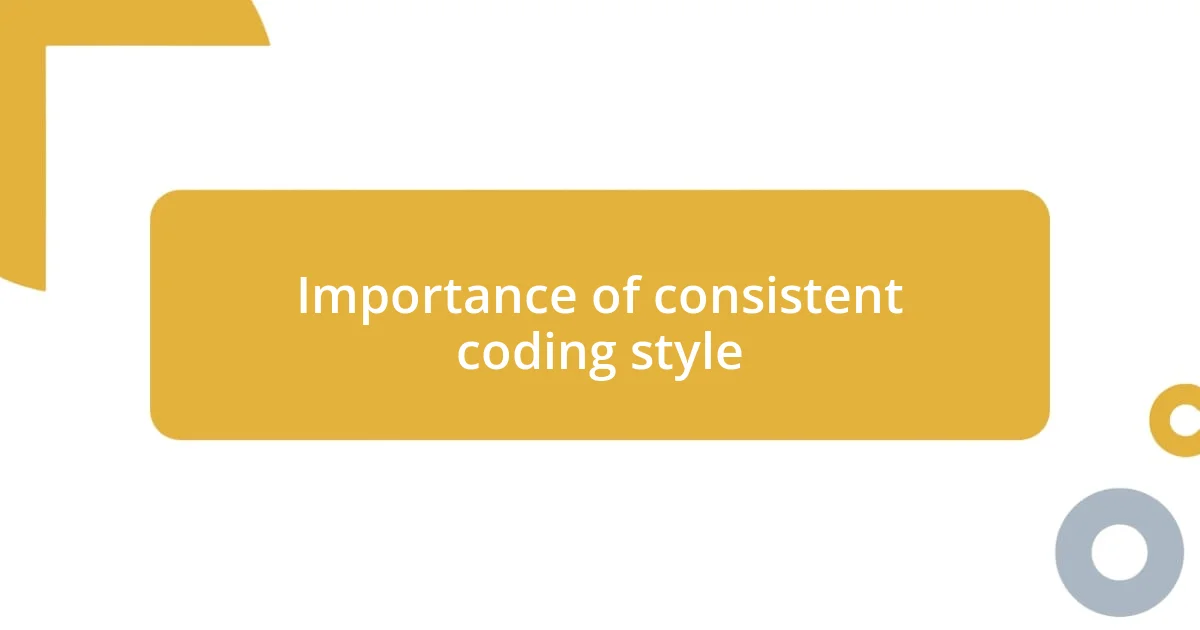
Importance of consistent coding style
Consistency in coding style plays a pivotal role in fostering collaboration and ensuring maintainability. I’ve experienced firsthand how a project can slow down when team members don’t adhere to the same conventions. I recall a stressful sprint where I spent an entire afternoon deciphering code that switched between different styles. It felt like trying to piece together a puzzle where half the pieces were missing. When everyone is on the same page, communication becomes seamless, and the code truly flows.
Here are some key reasons why a consistent coding style is essential:
- Improved Readability: Uniform formatting helps others quickly grasp the logic behind your code.
- Enhanced Collaboration: A common style reduces friction in team development, making onboarding smoother.
- Easier Maintenance: Consistency means less time spent figuring out how to navigate the codebase.
- Fewer Errors: When everyone follows the same rules, there’s a lower risk of introducing bugs through misinterpretation.
- Increased Productivity: With familiar structures, developers can focus on problem-solving rather than deciphering styles.
Ultimately, a consistent coding style sets a strong foundation where creativity and innovation can thrive.
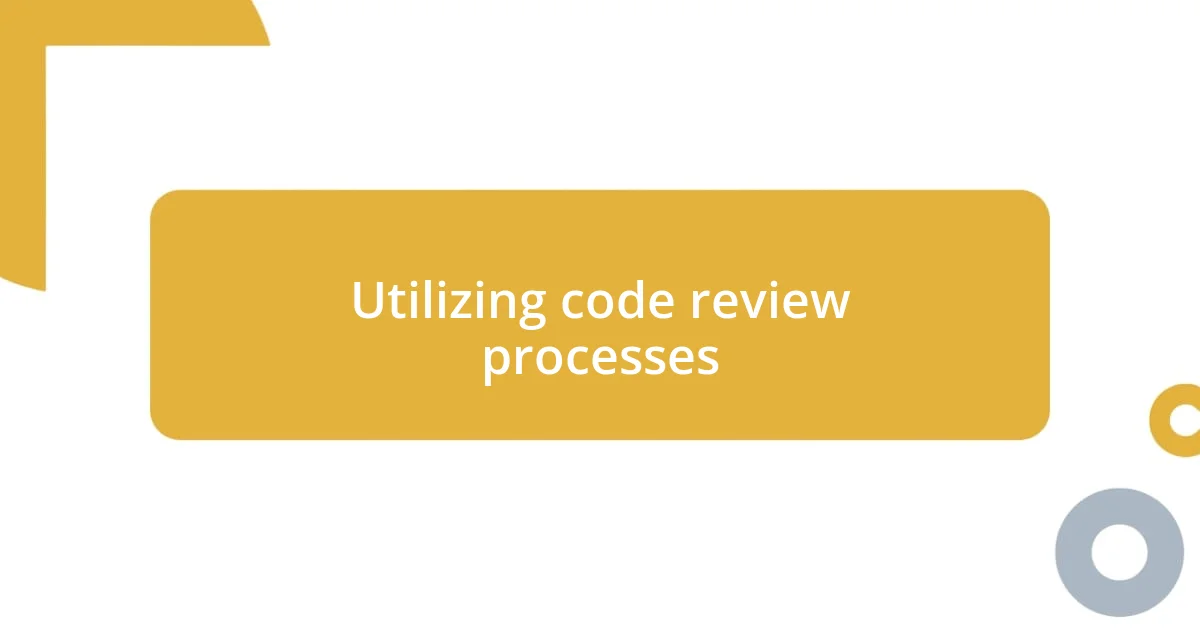
Utilizing code review processes
Utilizing code review processes is vital in maintaining clean code standards. I’ve learned through experience that a good code review isn’t just about spotting errors; it’s also a golden opportunity to share knowledge. For instance, during a review session on one of my projects, a teammate pointed out a cleaner approach to handling error cases that I hadn’t considered before. That moment reinforced my belief that collaborative insight can lead to better coding practices.
When conducting code reviews, I encourage an open dialogue among team members. I remember a particularly intense review where I had a different solution in mind, but discussing it led me to realize I had overlooked a more efficient path. The emotional rollercoaster from initially feeling defensive to eventually embracing a more thoughtful approach was astounding. The process of discussion not only refines the code but also fosters a culture of continuous learning and humility within the team.
To ensure the effectiveness of code reviews, I recommend establishing clear guidelines and checklists. This practice helps focus the review on essential elements, like coding standards and potential optimizations. For example, creating a checklist covering key aspects can guide reviewers who might forget critical points in the heat of the moment. It’s a simple yet powerful tool to keep everyone aligned and improve overall code quality.
| Aspect | Importance |
|---|---|
| Knowledge Sharing | Encourages collaborative insights and new ideas. |
| Open Dialogue | Fosters a culture of learning and team unity. |
| Guidelines & Checklists | Ensures thorough reviews and maintains focus on critical elements. |
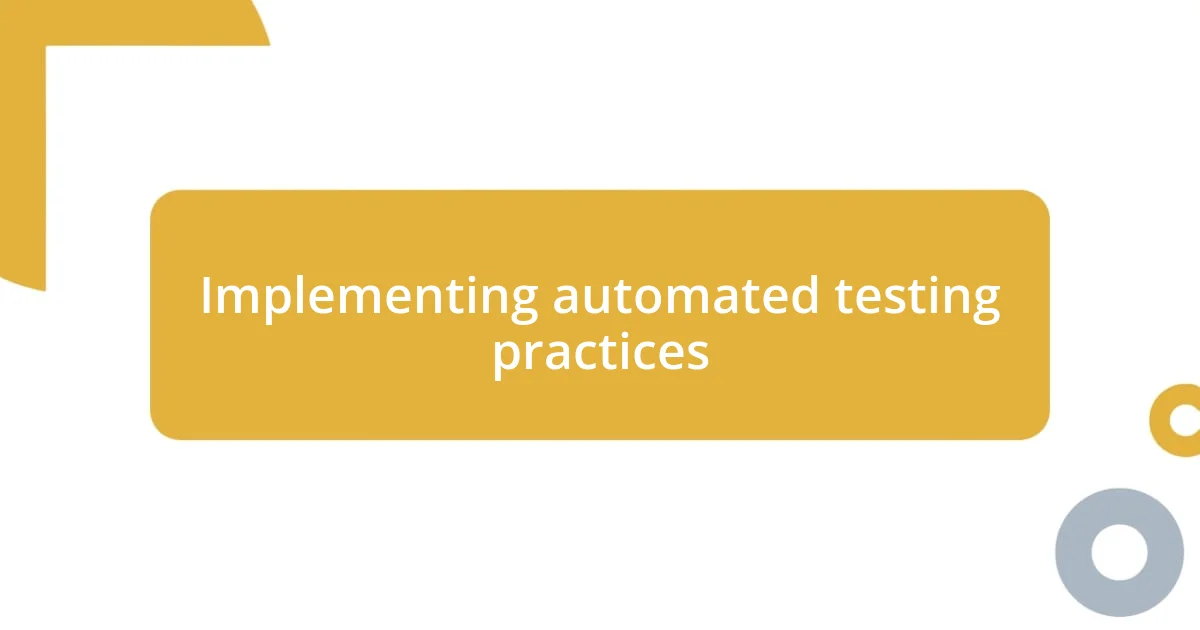
Implementing automated testing practices
Implementing automated testing practices has been a game-changer in my approach to clean code. I vividly remember the relief I felt the first time I ran a suite of automated tests and saw them all pass. It was like a safety net, allowing me to refactor code without a lingering worry about breaking existing functionality. How comforting is it to know you can iterate on your work with confidence?
When I adopted automated testing, I noticed a significant drop in the number of bugs introduced during development. For instance, in a recent project, my team and I established unit tests for critical components right from the start. This foresight not only enhanced our development speed but also gave us the freedom to innovate without the constant fear of regressions. Relying on automation has not just elevated the quality of code; it’s fostered a culture of accountability within the team.
Incorporating testing frameworks such as Jest or Mocha has streamlined our workflow. For me, the real benefit came during a tight deadline sprint when we faced an incoming change request. Since we already had a robust suite of automated tests, integrating new features and running tests took a fraction of the time it would have otherwise. I can’t stress enough how pivotal those automated checks were during that crunch time; they felt like a trusty co-pilot steering us through a storm.
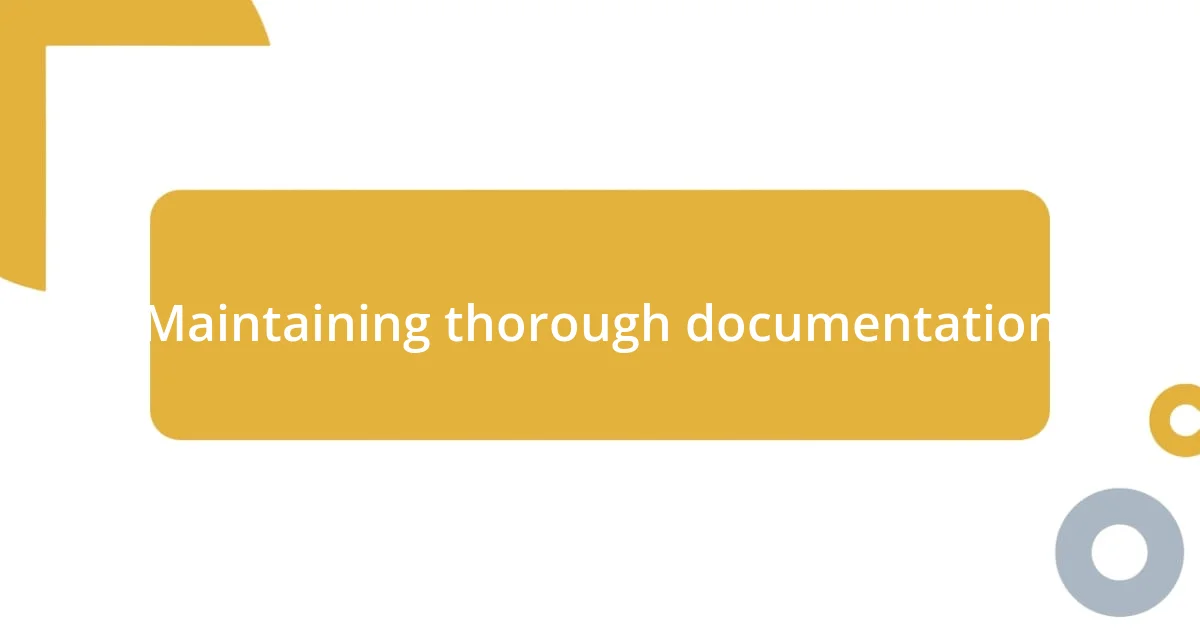
Maintaining thorough documentation
Maintaining thorough documentation is something I view as the backbone of clean coding practices. I remember the frustration I felt when working on a legacy project with little to no documentation. It was like navigating a maze without a map. As developers, we often think of documentation as a chore, but I’ve come to appreciate that it’s a powerful tool for clarity and efficiency. Every comment I write serves a purpose; it’s a way to communicate intent, making it easier for anyone, including my future self, to grasp complex logic down the line.
I’ve found that including detailed explanations not only keeps the code accessible but also reduces the onboarding time for new team members. There’s a sense of satisfaction in knowing that comprehensive documentation can simplify what could otherwise be a steep learning curve. For instance, when I joined a new team, I relied heavily on their well-structured documentation. It made me feel welcomed and empowered, knowing I had the resources to dive deep without constantly peppering my colleagues with questions. Isn’t it remarkable how effective documentation can enhance collaboration and build confidence among team members?
Organizing documentation in a clear, consistent manner has been another key to my success. I typically categorize documentation by project phases or components, which allows for easy navigation. One memorable experience was when I introduced a shared documentation platform into a project. The thrill in my team’s eyes as they realized they could contribute and access real-time updates was priceless. This collective ownership not only improved our code quality but also fostered a genuine sense of community. It’s amazing how a simple change in approach can transform the way we work together!
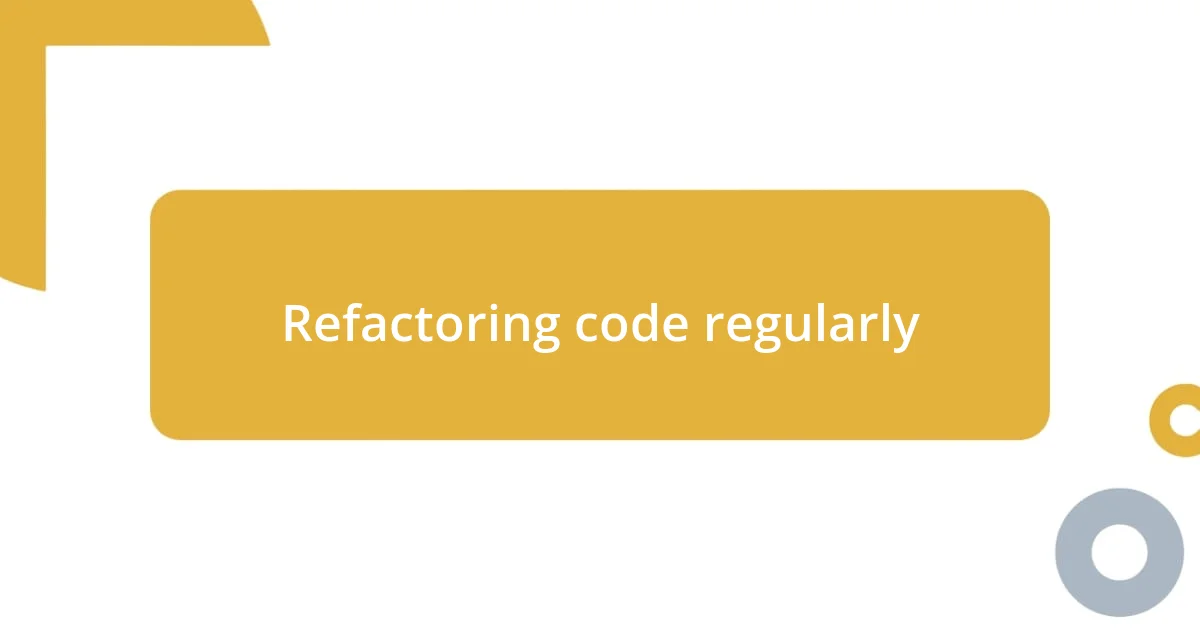
Refactoring code regularly
Refactoring code regularly has been a cornerstone of my development process; it’s like giving my code a refreshing makeover. I distinctly recall tackling a particularly unwieldy function that had grown over time into a behemoth with more responsibilities than it could handle. As I isolated its components, I felt an overwhelming sense of relief and clarity. Have you ever experienced that “aha” moment when you simplify something complex? It’s truly invigorating.
I’ve learned that dedicating time to refactor not only boosts code readability, but it also enhances maintainability. With each cycle of refactoring, I make it a point to eliminate redundancies and improve variable naming. Recently, I took some time to enhance a module responsible for data parsing. The satisfaction of transforming convoluted logic into streamlined, elegant code was immensely gratifying. It’s moments like these that reinforce my belief in the power of clean code.
When I integrate refactoring into my regular workflow, it opens up new avenues for innovation. I often think about how the best ideas can emerge from the clarity gained during these sessions. For example, after refactoring my code, I had the space to experiment with a new algorithm that significantly improved performance. This isn’t just about making things look pretty; it’s a practice that nourishes creativity and leads to stronger, more efficient code. How could you not want to evolve your work in such a meaningful way?
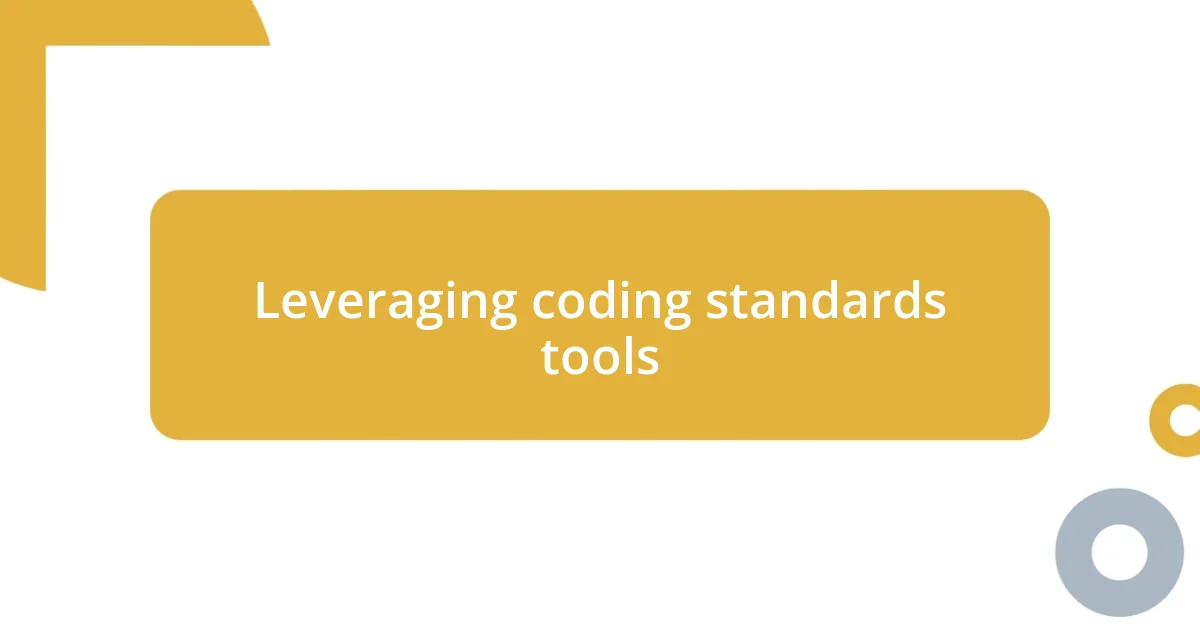
Leveraging coding standards tools
Leveraging coding standards tools has significantly refined my approach to writing clean code. I remember the first time I integrated a linter into my workflow; it felt like having a diligent coach by my side, pointing out all those pesky code style violations I otherwise overlooked. Most importantly, I discovered that tools like ESLint not only save time but also promote consistency across my projects. Have you ever noticed how standardized code feels more like a team effort rather than a collection of individual styles?
Using automated testing frameworks has also transformed my development process. By incorporating tools like JUnit and Mocha, I ensure that my code adheres to established standards while catching potential issues early on. One memorable instance was when a simple test revealed a subtle bug that, if left unchecked, could have spiraled into a much larger problem down the line. Isn’t it reassuring to know that these tools act as a safety net, allowing us to write with confidence?
Moreover, I’ve embraced integrated development environments (IDEs) that enforce coding standards in real-time. Tools like IntelliJ or Visual Studio Code highlight issues as I type, nudging me towards best practices without interrupting my flow. Recently, I found myself grateful for this feature when it underscored an overlooked best practice regarding code complexity. That split-second alert prompted me to rethink my approach and sparked a flurry of creative problem-solving. Isn’t it fascinating how leveraging the right tools can elevate not only the quality of our code but also our overall development experience?












